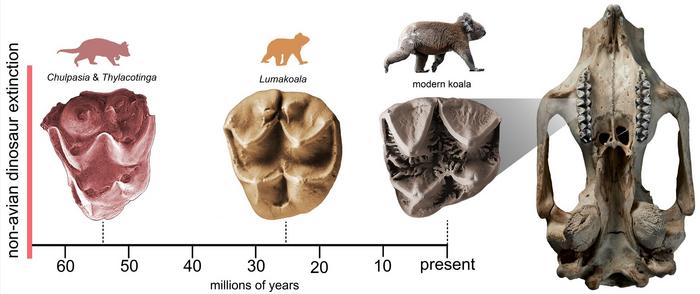Koalas are endangered in much of Australia now but in in the past there were multiple species living across the continent. The discovery of an ancient relative of the koala helps fill a 30 million year gap in the amazing evolution of Australia’s marsupials, according to a new study by Australian and British scientists published in Scientific Reports.

Credit: A Crichton (Flinders University)
Koalas are endangered in much of Australia now but in in the past there were multiple species living across the continent. The discovery of an ancient relative of the koala helps fill a 30 million year gap in the amazing evolution of Australia’s marsupials, according to a new study by Australian and British scientists published in Scientific Reports.
The study was led by Flinders University PhD student Arthur Crichton, who found fossil teeth of the new species at the Pwerte Marnte Marnte fossil site south of Alice Springs, thought to be about 25 million years old.
“The new species, which has been named Lumakoala blackae, weighed roughly 2.5 kg (about the size of a modern day brushtail possum, or a small domestic cat), and probably ate mostly soft leaves, but wouldn’t have turned down an insect given the chance,” says Mr Crichton, who analysed field samples collected in 2014 and 2020.
“Our computer analysis of its evolutionary relationships indicates that Lumakoala is a member of the koala family (Phascolarctidae) or a close relative, but it also resembles several much older fossil marsupials called Thylacotinga and Chulpasia from the 55 million-year-old Tingamarra site in northeastern Australia.
“In the past, it was suggested the enigmatic Thylacotinga and Chulpasia may have been closely related to marsupials from South America.
“However, the discovery of Lumakoala suggests that Thylacotinga and Chulpasia could actually be early relatives of Australian herbivorous marsupials such as koalas, wombats, kangaroos and possums.”
“This group (Diprotodontia)is extremely diverse today, but nothing is known about the first half of their evolution due to a long gap in the fossil record.”
“If our hypothesis is correct, it would extend the diprotodontian fossil record back by 30 million years. We would really expect early diprotodontians to have been around at the time; molecular information suggests koalas, wombats, kangaroos and possums split off from other marsupials between about 65 million and 50 million years ago.”
Co-author Associate Professor Robin Beck, from England’s University of Salford, says the discovery of Lumakoala helps fill a major 30 million-year-old gap in Australian marsupial evolution.
“These Tingamarran marsupials are less mysterious than we thought, and now appear to be ancient relatives of younger, more familiar groups like koalas,” says Dr Beck.
“It shows how finding new fossils like Lumakoala, even if only a few teeth, can revolutionise our understanding of the history of life on Earth.”
The study raises important new questions, including whether these relatives of Australian herbivorous marsupials once lived in South America and Antarctica, Dr Beck says, adding there are South American fossils that look very similar to the Tingamarran marsupials.
The new study also reports the presence of two other types of koala – Madakoala and Nimiokoala – that lived alongside Lumakoala, filling different niches in the central Australian forests that flourished 25 million years ago.
Professor Gavin Prideaux, director of the Flinders University Palaeontology Laboratory, describes the late Oligocene (23–25 million years ago) as a “kind of the koala heyday”.
“Until now, there’s been no record of koalas ever being in the Northern Territory; now there are three different species from a single fossil site,” says Professor Prideaux.
“While we have only one koala species today, we now know there were at least seven from the late Oligocene – along with giant koala-like marsupials called ilariids.
Iliariids were the largest marsupials in Australia at the time, weighing in at up to 200 kg. They lived alongside a strong-toothed wombat relative named Mukupirna fortidentata and bizarre possum, Chunia pledgei.
The article, A probable koala from the Oligocene of central Australia provides insights into early Diprotodontia evolution (2023) ) by Arthur I Crichton, Robin MD Beck, Aidan MC Couzens, Trevor H Worthy, Aaron B Camens and Gavin J Prideaux has been published in Scientific Reports. DOI: 10.1038/s41598-023-41471-0.
Photos, map and graphics at the link: Reconstruction illustration by Peter Schouten
https://onedrive.live.com/view.aspx?resid=2D5755806FD48E50!86300&cid=2d5755806fd48e50&authkey=!ALLHScFGz3u4qK4&CT=1693887499272&OR=ItemsView
Journal
Scientific Reports
DOI
10.1038/s41598-023-41471-0
Method of Research
Observational study
Subject of Research
Animals
Article Title
A probable koala from the Oligocene of central Australia provides insights into early Diprotodontia evolution
Article Publication Date
5-Sep-2023




